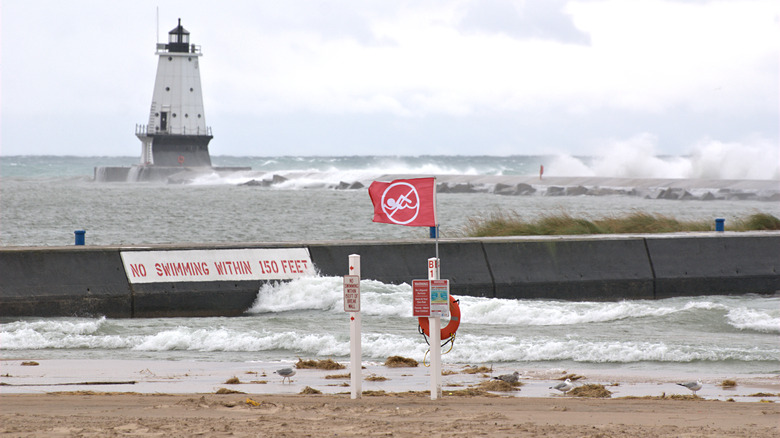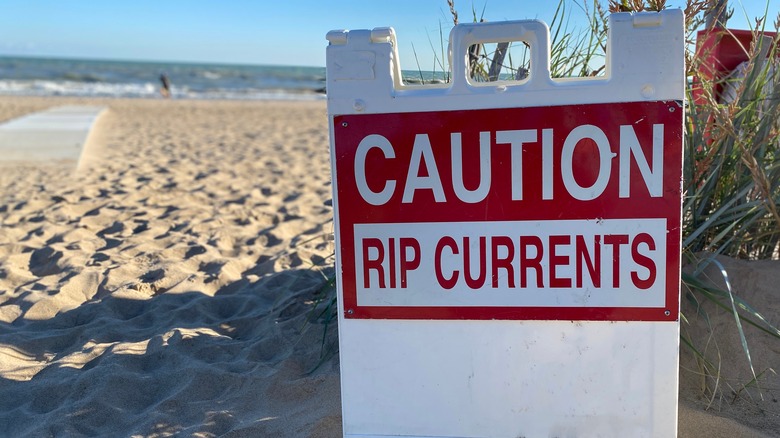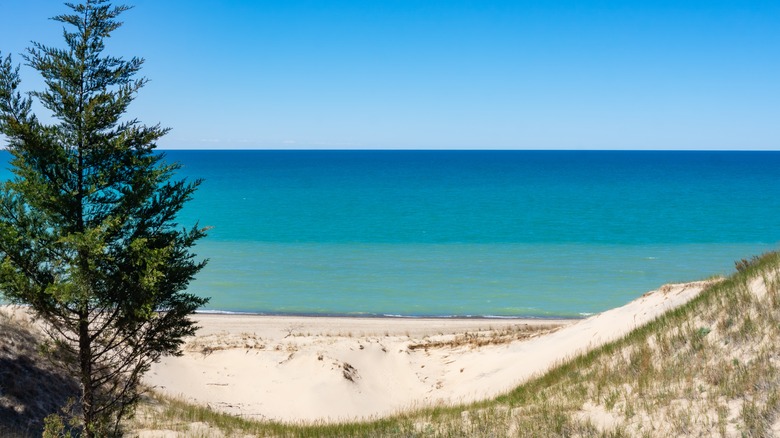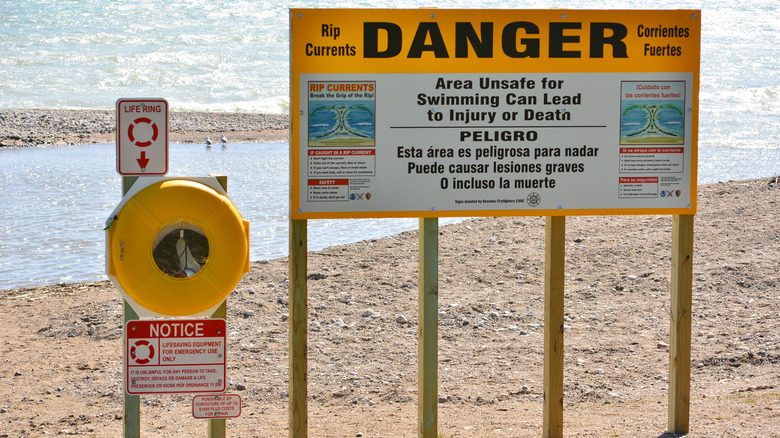If You're Planning A Trip To Lake Michigan, Steer Clear Of These Deadly Beaches
Lake Michigan is an incredibly popular destination in the Midwest that attracts tourists and locals alike. Known for its stunning views and beautiful beaches, it is a go-to spot for those who love water sports, sunbathing, or swimming. From the sandy landscapes of Sleeping Bear Dunes National Lakeshore to the vibrant cityscape backdrop of Chicago's waterfront, Lake Michigan's shores offer a picturesque escape. However, it's important to note that not all beaches are created equal, and some beautiful swimming spots around the Great Lakes can be quite dangerous.
According to the Great Lakes Surf Rescue Project, there were 39 drownings in Lake Michigan in 2023. That's higher than all the other Great Lakes combined, proving some beaches are inherently more dangerous than others. The weather patterns at Lake Michigan can be unpredictable, and the water can become dangerous due to strong currents. Hazardous bacteria can sometimes be present, as well. So, if you want to enjoy Lake Michigan's natural beauty, make sure to plan ahead, be aware of the risks, and take steps to stay safe.
Current-related incidents in Lake Michigan
Lake Michigan is North America's third largest Great Lake, with a surface area of 22,404 square miles and an average depth of 279 feet. According to the National Weather Service (NWS), Lake Michigan has the most current-related incidents of all the Great Lakes. From 2002 to 2020, there were more than 450 current-related incidents, including rescues and fatalities on Lake Michigan.
Beaches are sometimes closed, and swimmers are advised not to enter the water due to hazardous longshore and rip currents. These currents are caused by high winds that blow across the lake's surface, which are particularly fast due to the lack of land obstructions to slow them down. When wind forces a large amount of water towards the shore, a rip current is formed, which is a stream of water rushing in the opposite direction. Longshore currents, on the other hand, travel parallel to the shore. If a swimmer is caught in a rip current, they can be dragged away from shore, and it may be nearly impossible to swim against the current, depending on its strength.
Beaches with higher risks of incidents
Some Lake Michigan beaches are more prone to incidents than others. For instance, South Haven in Michigan has had at least nine deaths since 2019, followed by Indiana Dunes Beach and Holland State Park, both in Indiana, with five deaths in the same period. This area, between northwest Indiana and southwest Michigan, is known for strong winds that create large waves and swift currents, making it risky for swimmers. "You may have great swimming ability in a pool, but when you get into Lake Michigan, the water is rough there is currents and wind and waves," Bob Pratt, the education director for the Great Lakes Surf Rescue Project, told WWMT News.
Most of Lake Michigan's beaches have been without lifeguards since 1993, which increases the chance of drowning. Only Silver Beach and New Buffalo Beach in southwest Michigan, which are two of the most hazardous due to rip currents, have lifeguards. Other dangerous beaches include Warren Dunes State Park, Pere Marquette Park, Washington Park Beach, Michigan City Beach, Indiana Beach, and Grand Haven State Park.
Bacterial threats at Lake Michigan's beaches
Like other bodies of water, Lake Michigan can also become contaminated with harmful bacteria such as Escherichia coli (E. coli), which can cause vomiting, diarrhea, and infection. The State of Michigan explains that the presence of E. coli can indicate an unsafe amount of feces in the water, meaning other dangerous bacteria or pathogens could also be present. It can enter the water through overflow or runoff from waste management plants, farms, pets on the beach, or seagulls and other water birds.
Many towns with beaches along Lake Michigan keep a close eye on the levels of E. coli every few days and issue warnings or close the beaches based on their findings. The Michigan BeachGuard System is a public resource that provides information on water quality sampling results, beach advisories, and closures for Michigan's beaches. The Indiana Department of Environmental Management (IDEM) also gathers E. coli monitoring data on Lake Michigan's beaches and informs the public about contamination advisories and beach closures.
Measures taken to improve Lake Michigan's safety
Efforts have been made to improve the safety of swimmers in Lake Michigan. The Great Lakes Water Safety Consortium has played an important role in raising awareness about water safety. The consortium's website provides valuable safety tips, educational resources, and up-to-date information about water conditions. This helps swimmers make informed decisions. In South Haven, residents have created the South Haven Ambassadors Program and Education (SHAPE) to improve safety standards at the city's beaches. They're working towards making South Haven a safer place to swim and enjoy the beach by recruiting volunteers to monitor the beaches and educating beachgoers.
The Michigan Department of Natural Resources has taken steps to designate safer swimming areas in state parks. Along with the beach flag warning system, these areas have additional safety measures such as markers and buoys, and the water depths are generally less than 5 feet. These markings appear before Memorial Day weekend and stay throughout the summer.
Laws have been passed to improve safety on Lake Michigan's shores, as well. In 2022, Illinois passed a law that requires public rescue equipment, such as life ring buoys, to be installed at access points, piers, and beaches to ensure that life-saving equipment is easily accessible to the public.
Staying safe at Lake Michigan's beaches
Before heading out to the beach, check on current conditions. It's also crucial to keep an eye on the weather by regularly checking updates from the National Weather Service. Always follow the posted signs and safety rules issued by the local authorities. And, of course, it's always safer to swim with a buddy. Learning about the Great Lakes flag warning system used at swim beaches is also important. According to the Michigan Department of Natural Resources, the flags represent different water conditions, with double red flags indicating that it's unsafe to enter the water, red flags signaling high hazards, yellow flags indicating medium hazards, and green flags representing low hazards.
Avoid swimming at visible discharge pipes or urban beaches after heavy rainfall. Wade or swim without submerging your head to avoid swallowing water and becoming exposed to pathogens. Also, avoid water contact if you have any breaks in the skin, such as cuts or open sores. When visiting Lake Michigan, it's important to prioritize safety while having fun. The lake offers stunning views and exciting activities, but it's important to be cautious and stay informed.





